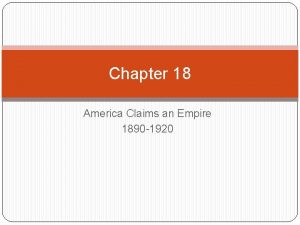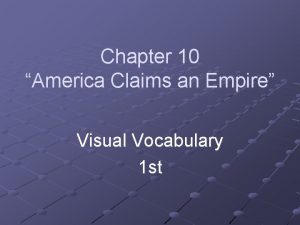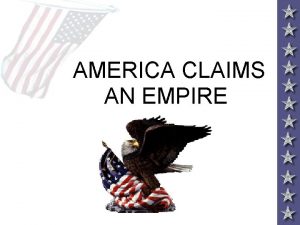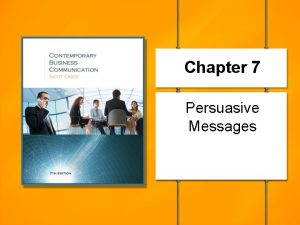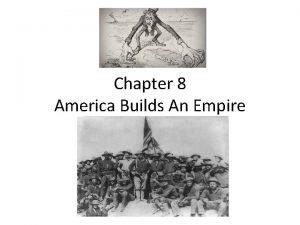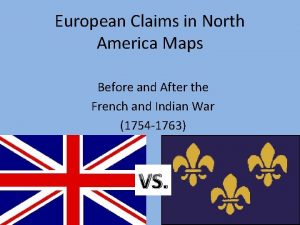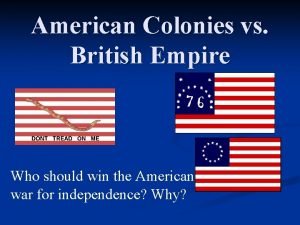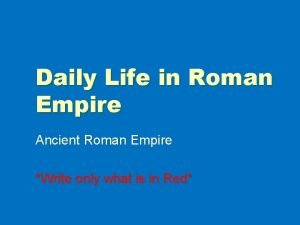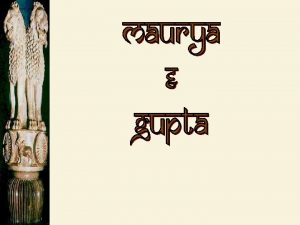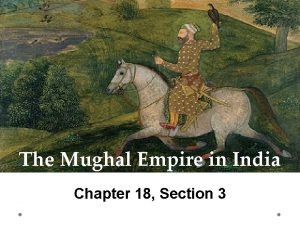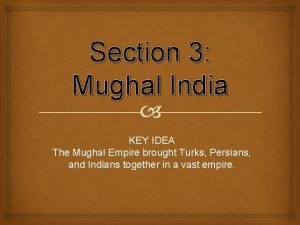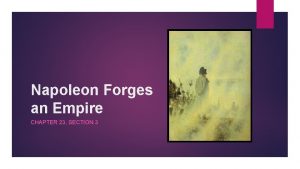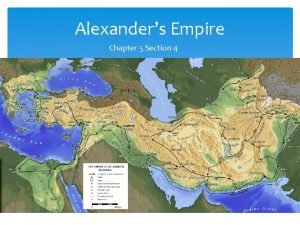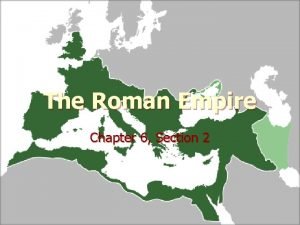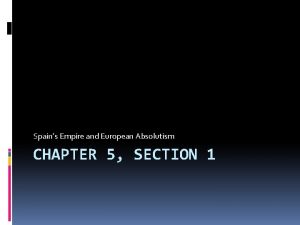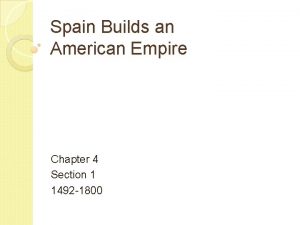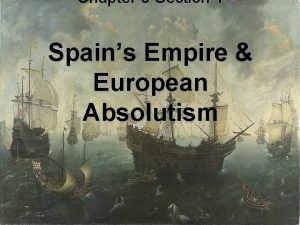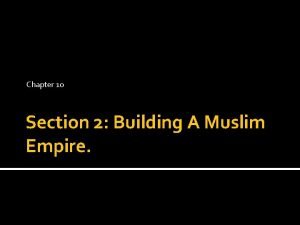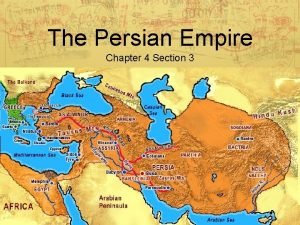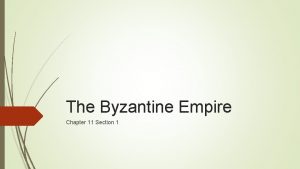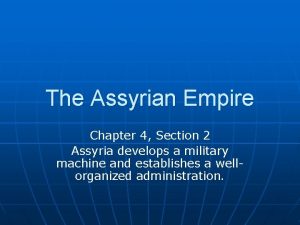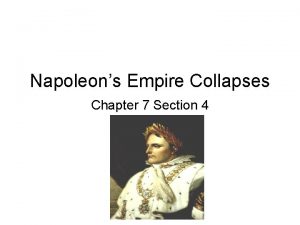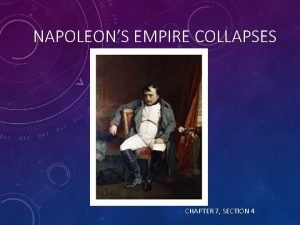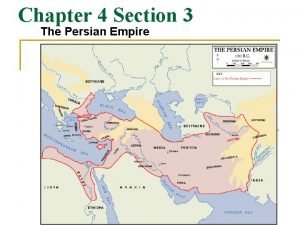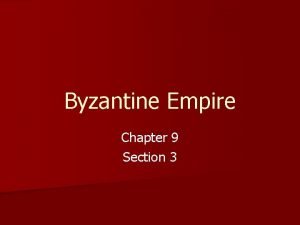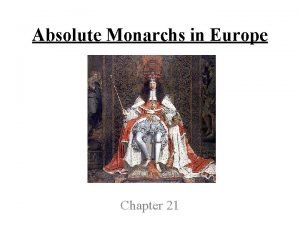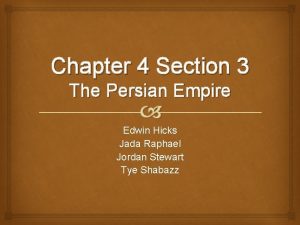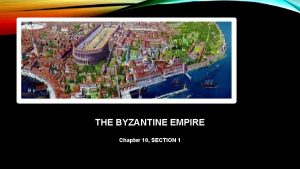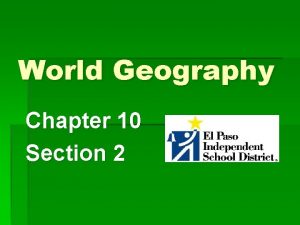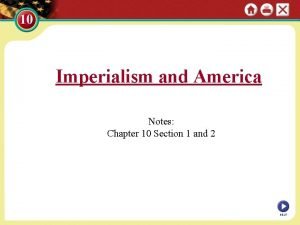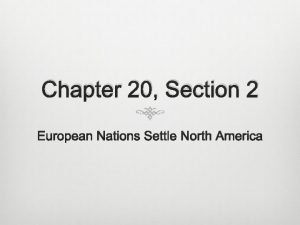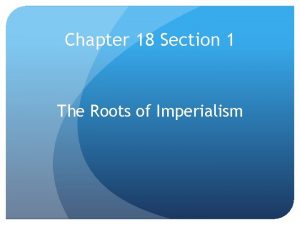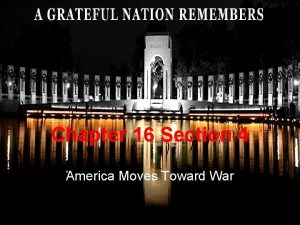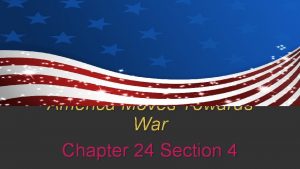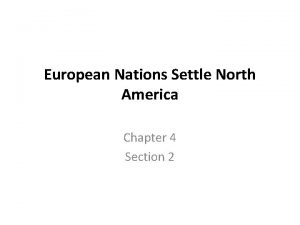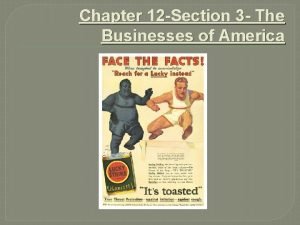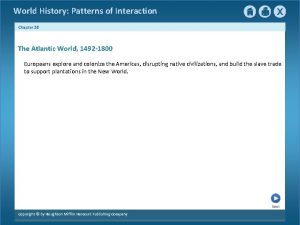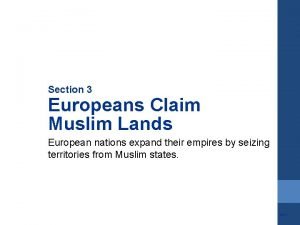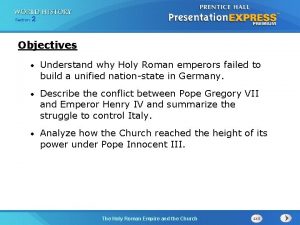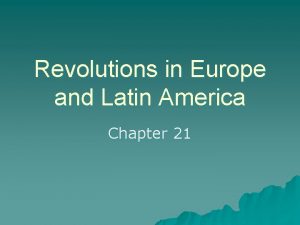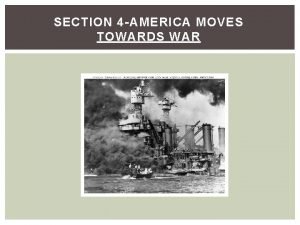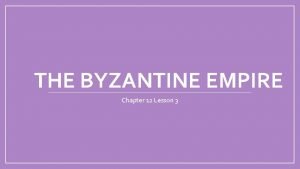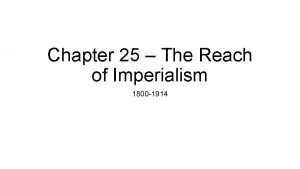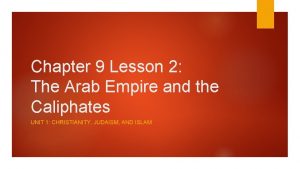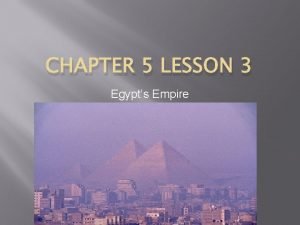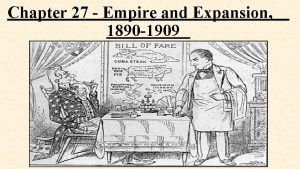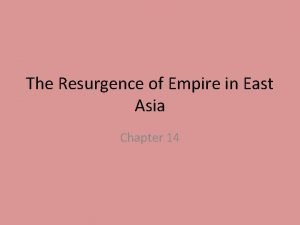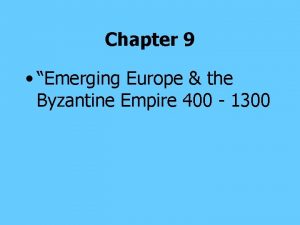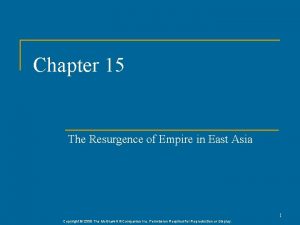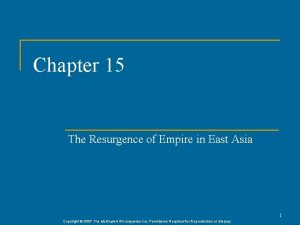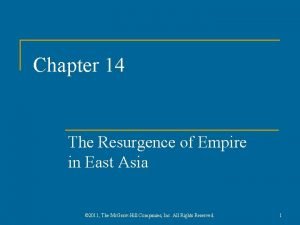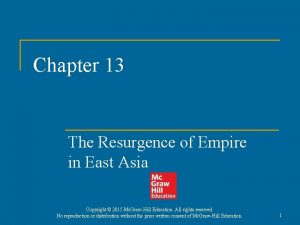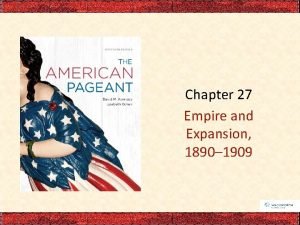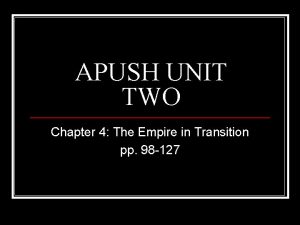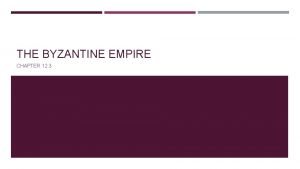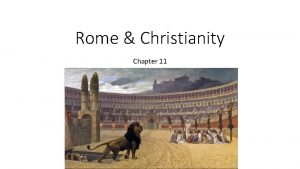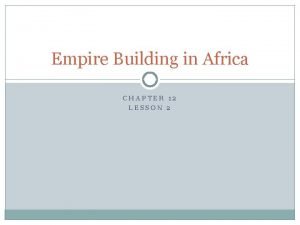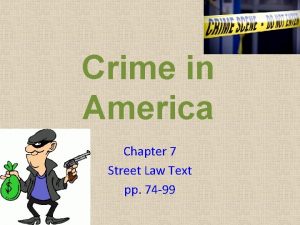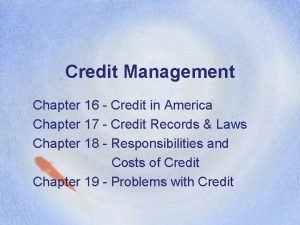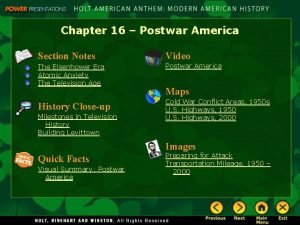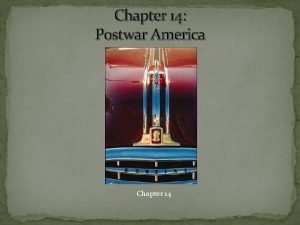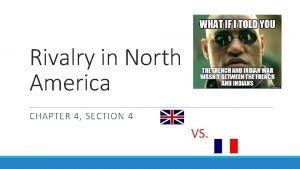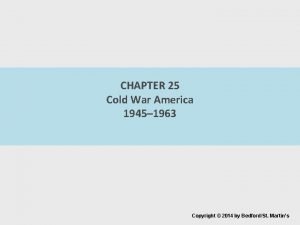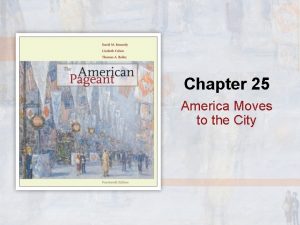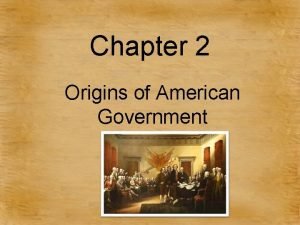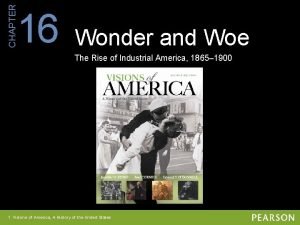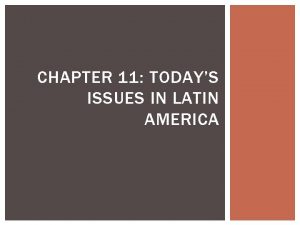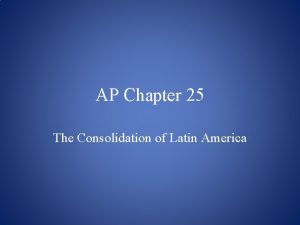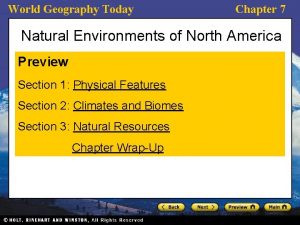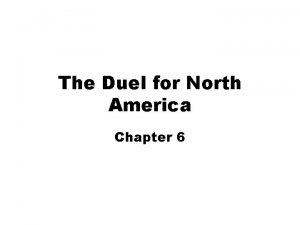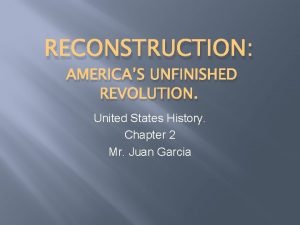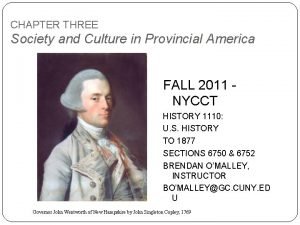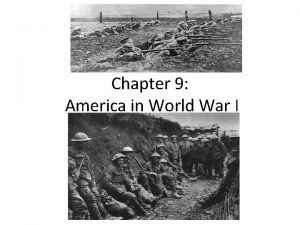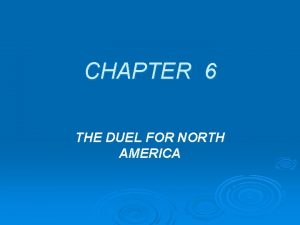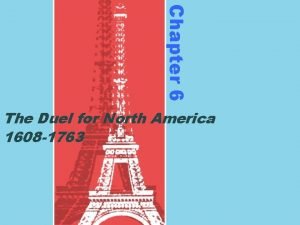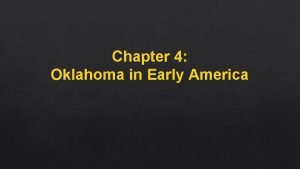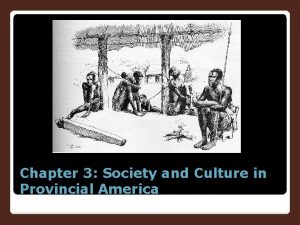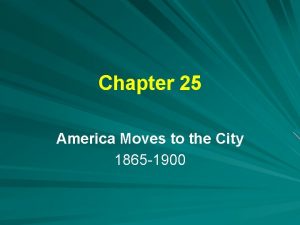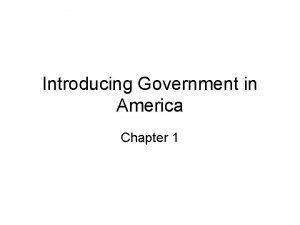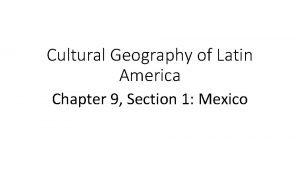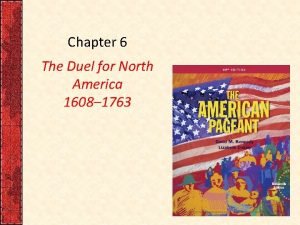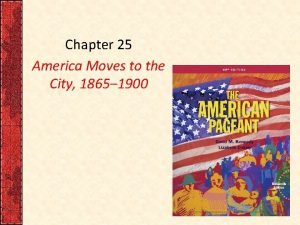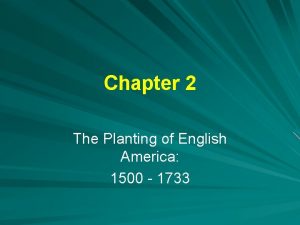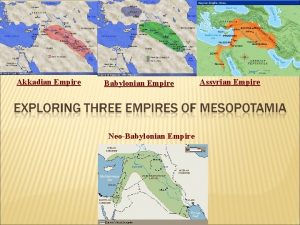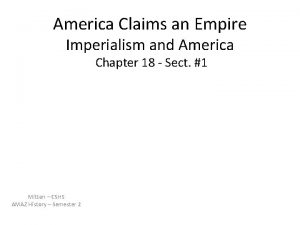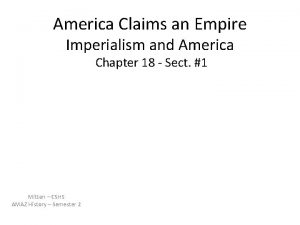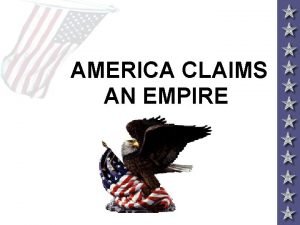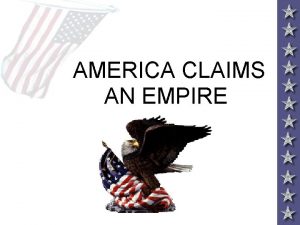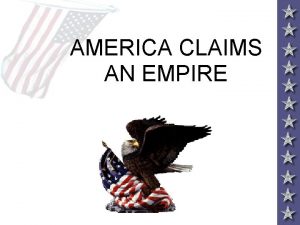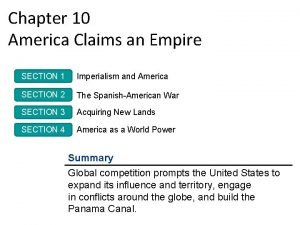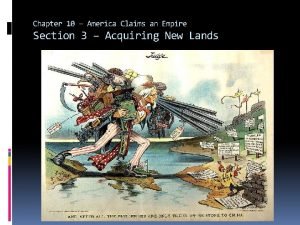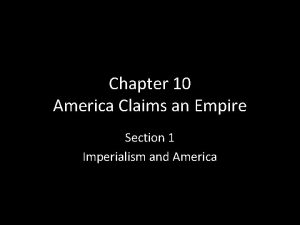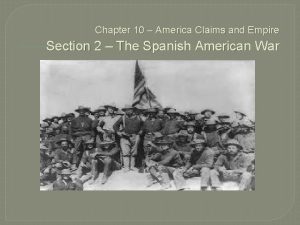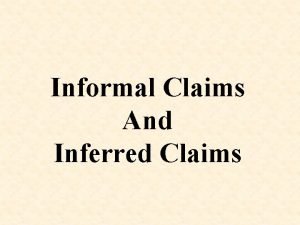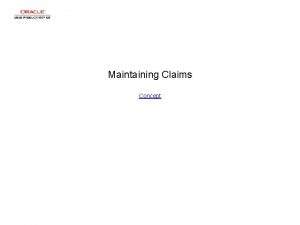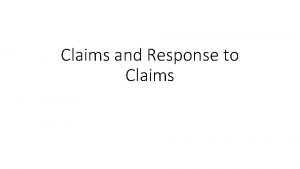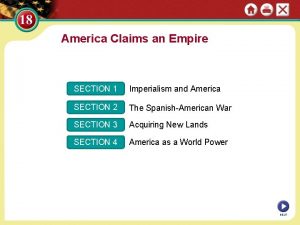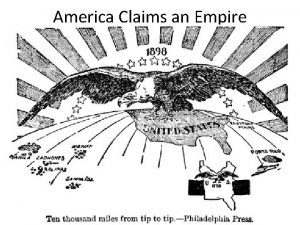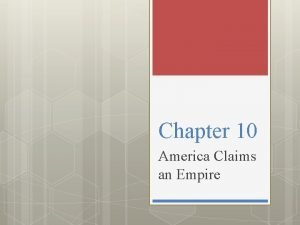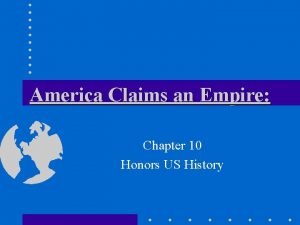CHAPTER 10 AMERICA CLAIMS AN EMPIRE Section 1






































































































- Slides: 102

CHAPTER 10 AMERICA CLAIMS AN EMPIRE

Section 1 Imperialism and America Beginning in 1867 and continuing through the century, global competition causes the United States to expand. NEXT

Section 1: IMPERIALISM AND AMERICA I. American Expansionism A. Throughout the 19 th century America expanded their control of the continent to the Pacific Ocean (Manifest Destiny) B. Global Competition 1. Imperialism —policy of extending control over weaker nations C. In 1800 s, Europeans divide up most of Africa, compete for China D. Japan joins race for China; U. S. decides to expand overseas

E. WHY IMPERIALISM? 1) Desire for Military strength – Mahan advised strong navy a) Political rivalries – Each nation wanted a larger empire than the other, which led to more world power. b) Admiral Alfred T. Mahan urges U. S. to build up navy to compete and influence world c) U. S. builds modern battleships, becomes third largest naval power – began under T. Roosevelt 2) Thirst for new markets – to spur economy & trade. a) Industrial countries needed raw materials and markets for their surplus goods. • U. S. farms, factories produce more than Americans can consume • U. S. needs raw materials, new markets for goods b) Foreign trade: solution to overproduction, unemployment, depression 3) Belief in Cultural Superiority a) Some combine Social Darwinism, belief in superiority of Anglo-Saxons, Manifest Destany - US leaders believed their culture was superior to any in the world (Western).

Alfred T. Mahan U. S. naval officer who helped convince American leaders of the importance of maintaining a large navy and overseas territories.

Anglo-Saxonism • Idea that came from Social Darwinism • English-Speaking nations were superior –Character –Ideas –Systems of Government • Destined to dominate the planet

F. Growth of a Modern Navy 1. Americans became interested in protecting their interests overseas. 2. This required a navy that could compete with Europeans.

II. THE U. S. ACQUIRES ALASKA Early Expansion A. William Seward —Secretary of State under Lincoln, Johnson B. 1867, arranges purchase of Alaska from Russia for $7. 2 million 1. has trouble convincing House to fund purchase Alaska called “Seward’s Icebox, ” “Seward’s Folly” C. Alaska rich in timber, minerals, oil and after Seward's death, gold was discovered in Alaska. C. Became a state in 1959 ska Ala

III. U. S. TAKES HAWAII A. The Cry for Annexation ince 1790 s, U. S. merchants stop in Hawaii on way to China, India 1820 s, Yankee missionaries found schools, churches on islands B. Mid-1800 s, American-owned sugar plantations 75% of islands’ wealth C. 1887, U. S. pressures Hawaii to allow naval base at Pearl Harbor 1. becomes refueling station D. 1890 Mc. Kinley Tariff eliminates duty-free (tax free) status of Hawaiian sugar E. Planters call for U. S. to annex islands so will not have to pay duty

H. Importance of Hawaii 1. Midway between the U. S. and Asia. 2. Climate allowed for growing sugar, fruit. 3. U. S. began trade and settlement of Hawaii in 1887.

The End of a Monarchy F. Queen Liliuokalani removed by business groups-1893 G. Set up government headed by Sanford B. Dole • President Cleveland cannot make Dole surrender power to queen • recognizes Republic of Hawaii H. Under President Mc. Kinley, Congress proclaims Hawaii U. S. territory 1898 1. Annexation-to add on http: //www. history. com/topics/usstates/hawaii

Queen Liliuokalani

Location of Hawaii

SECTION 2: THE SPANISH AMERICAN WAR I. Cubans Rebel against Spain A. During 1868– 1878 Cuban war for independence, American sympathies with Cuba B. 1886 abolition of slavery leads to U. S. investment in sugar cane Cuba is just 90 miles south of Florida

C. Latin American 1. U. S leaders wanted more trade and cooperation with Latin America. 2. Wanted to show Europe that US was the dominant power in Latin America 3. Cuba is in Latin America.

Latin America

The Spanish. American War

CUBA’S SECOND WAR FOR INDEPENDENCE D. José Martí —poet, journalist —launches second revolution in 1895 1. Cuban revolutionary leader • Raised money from Americans • Planned an invasion of Cuba • Guerrilla campaign destroys American-owned sugar mills, plantations E. U. S. public opinion split: 1. business wants to support Spain 2. others favor Cuban cause- a revolt against colonial Marti (Marti deliberately destroyed property, including American sugar plants, hoping to provoke American intervention)

Economic Ties to Cuban sugar imported into the U. S. Investments in Cuban mines, railroads and sugar plantations

II. WAR FEVER ESCALATES Spain Takes Action • 1896, General Weyler sent to Cuba to restore order • Puts about 300, 000 Cubans in concentration camps Headline Wars A. Newspapers exploit Spain’s abusive actions in circulation war 1. Yellow journalism — sensational writing used to lure, enrage readers B. Newspaper publishers William Randolph Hearst (New York Journal) and Joseph Pulitzer (New York World) exaggerated Spanish atrocities and brutality in “Headline Wars” Political cartoon: Pulitzer (left) and Hearst escalating and instigating war between the U. S. and Spain

Yellow Journalism writers exaggerate or make up stories to attract readers. Support for Cuban rebels

Example of Yellow Journalism

Modern yellow journal

Joseph Pulitzer Publisher of the New York World.

William Randolph Hearst • Publisher of the New York Journal.


Mc. Kinley’s Position on the War C. Headlines increase American sympathy for independent Cuba D. Mc. Kinley wants to avoid war, tries diplomacy to resolve crisis E. Private letter by Spanish minister Enrique Dupuy de Lôme published= The de Lôme Letter 1. calls Mc. Kinley weak, swayed by public F. Spain apologizes, de Lôme resigns; American public angry

U. S. S. MAINE EXPLODES Before After G. Early in 1888, U. S. S. Maine sent to pick up, or evacuate, U. S. citizens, protect U. S. property H. February 15, 1898 the Maine blows up in Havana harbor; newspapers blame Spain I. A navy report Spanish mine had sunk the ship. (More than 260 men were killed)

III. WAR ERUPTS WITH SPAIN A. Congress declared war on April 19, 1898. B. “Remember the Maine!” became a rallying cry for U. S. intervention in Cuba

War with Spain Erupts “Remember the Maine!” • American people blamed Spain. • Mc. Kinley was under tremendous pressure to declare war. The U. S. Declares War

U. S. S. Maine

The Maine Explodes Unknown artist , 1898 Notice the men flying dramatically through the air

Wreckage of the Maine


“Remember the Maine!”

Jingoism • An attitude of aggressive nationalism. • Very strong after the Maine incident.

C. Causes of Spanish American war 1. American support for Cuban rebels 2. Yellow journalism 3. Explosion of the USS Maine

D. War on Two Fronts U. S. forces fought the Spanish in two areas: (colonies) 1. A land war in Cuba. 2. A naval battle in the Spanish Colony of the Philippines.

War on Two Fronts

E. Advantages over Spain 1. Newer and better battleships 2. Spanish were poorly trained

THE WAR IN THE PHILIPPINES F. The War in the Philippines 1. First battle with Spain occurs in Spanish colony of the Philippines 2. Commodore George Dewey destroys Spanish fleet in Manila harbor- defeated the Spanish in the Battle of Manila Bay 3. Filipinos, led by revolutionary leader Emilio Aguinaldo, support Dewey 4. August 1898, Spanish troops in Manila surrender to U. S.

George Dewey • American Admiral who defeated the Spanish in the Battle of Manila Bay.

Emilio Aguinaldo • Filipino revolutionary leader. • Unrest developed between Filipino revolutionaries and the Americans.

Philippines

I. THE WAR IN THE CARIBBEAN 1. U. S. blockades Cuba; Spanish fleet in Santiago de Cuba harbor followed by a land invasion by Roosevelt’s Rough Rider 2. Spanish fleet tries to escape blockade, is destroyed in naval battle 3. U. S. troops invade Puerto Rico soon after 4. Unlike navy, U. S. army has small professional force, many volunteers a) volunteers ill-prepared, illsupplied

Cuba


J. Rough Riders 1. Rough Riders —Leonard Wood, Theodore Roosevelt lead volunteer cavalry 2. Roosevelt declared hero of attack on strategic San Juan Hill http: //www. history. com/topics/spanishamerican-war

Theodore Roosevelt • Second in command of the Rough Rider unit. • http: //www. history. com /videos/roosevelt-fights -in-spanish-americanwar#roosevelt-fights-in -spanish-american-war

Roosevelt and the Rough Riders

Charge of the Rough Riders

U. S. WINS; SIGNS TREATY OF PARIS K. Spain, U. S. sign armistice August 1898; meet in Paris to make treaty. Treaty of Paris 1. ending what Secretary of State John Hay called “a splendid little war” 2. Spain frees Cuba; hands Guam, Puerto Rico to U. S. ; sells Philippines $20 million Debate over the Treaty L. Treaty of Paris touches off great debate over imperialism M. Mc. Kinley tries to justify annexation of Philippines on moral grounds N. Opponents give political, moral, economic arguments against Treaty of Paris, 1898

SECTION 3: ACQUIRING NEW LANDS I. Military Rule A. During Spanish-American War, General Nelson A. Miles occupies Puerto Rico 1. People split on independence, statehood, self-government under U. S. 2. important to the U. S. strategically as post in the Caribbean, for protection of future canal. B. 1900, Foraker Act sets up civil government 1. president appoints governor, upper house 2. 1917, Puerto Ricans made U. S. citizens; elect both houses

II. CUBA AND THE UNITED STATES A. U. S. recognizes Cuban independence from Spain B. U. S. makes Cuba add Platt Amendment to its 1901 constitution C. Platt Amendment does not allow Cuba to go into debt; also stipulates 1. no treaties that let foreign power control land 2. U. S. has right to intervene 3. U. S. can buy, lease land for navy D. D. Cuba had become a “protectorate” of the U. S. 1. Protectorate —country whose affairs partly controlled by stronger one Today the U. S. has a prison in Guantanamo Bay, Cuba

Cuba and the United States Protecting American Business Interests E. U. S. wants strong political presence to protect American businesses F. Some object to colonial entanglements, do not think colonies needed G. U. S. state department continues to push for control of Latin America NEXT

III. FILIPINOS REBEL Philippine-American War A. Filipinos outraged at Treaty of Paris call for annexation B. 1899, rebel leader, Emilio Aguinaldo leads fight for independence against U. S. C. The 3 -year war claimed 20, 000 Filipino rebels, 4, 000 American lives and $400, 000 (20 x the price the U. S. paid for the land) Aftermath of the War D. U. S. president appoints governor who appoints upper house 1. people elect lower house E. July 4, 1946, Philippines become independent U. S. troops fire on rebels

Pacific Expansion • U. S. leaders saw the economic benefit of starting trade with Japan and China.

IV. FOREIGN INFLUENCE IN CHINA U. S. Interest in China A. U. S. sees China as vast potential market, investment opportunity B. France, Britain, Japan, Russia have settlements, spheres of influence - area where a foreign country controlled the economic development-in China C. U. S. Secretary of State John Hay issues Open Door Notes = ask imperialist nations to share trading rights (free trade) with U. S. Other powers reluctantly agree Foreign nations were opening the door to China’s trade

Spheres of Influence- An area in China where a foreign country controlled the economic development.

BOXER REBELLION D. Europeans dominate most large Chinese cities E. Chinese form secret societies, including Boxers, to expel foreigners F. Boxers kill hundreds of foreigners, Chinese converts to Christianity. BOXER REBELLION G. U. S. , Britain, France, Germany, Japan put down Boxer Rebellion

Chinese Boxer


Execution of Boxers

V. AMERICANS PROTECT RIGHTS IN ASIA Protecting American Rights A. Hay issues new Open Door notes saying U. S. will keep trade open- Open Door Policies B. Open Door policy reflects beliefs about U. S. economy: 1. growth depends on exports 2. U. S. has right to intervene keep markets open 3. closing of area threatens U. S. survival or America’s survival depended on access to foreign markets

VI. The Impact of U. S. Territorial Gains A. The Anti-Imperialist League B. Mc. Kinley’s reelection confirms most Americans favor imperialism C. Anti-Imperialist League has prominent people from different fields D. For various reasons, agree wrong to rule others without their consent

SECTION 4: AMERICA AS A WORLD POWER The Nobel Peace Prize is awarded annually I. Teddy Roosevelt and the World Roosevelt does not want Europeans to control world economy, politics A. Two events signaled America’s climb toward being the#1 world power 1. Roosevelt negotiates settlement between Russia and Japan who had been at War =Treaty of Portsmouth: Japan gets Manchuria, Korea • U. S. , Japan continue diplomatic talks • pledge to respect each other’s possessions a) won Roosevelt the 1906 Nobel Peace Prize 2) Construction of Panama Canal

II. THE PANAMA CANAL A. U. S. wants canal to cut travel time of commercial, military ships U. S. buys French company’s route through Panama (Columbia controls) B. Negotiates with Colombia to build Panama Canal; talks break down C. French company agent helps organize Panamanian rebellion 1. U. S. gives military aid D. U. S. , Panama sign treaty; U. S. pays $10 million for Canal Zone “The shortcut”

BUILDING THE PANAMA CANAL 1904 -1914 Constructing the Canal E. Construction of canal is one of world’s greatest engineering feats 1. fight diseases, geographic obstacles 2. at height, 43, 400 workers employed Cost- $380 million Workers – Over 40, 000 (5, 600 died) Time – Construction took 10 years

Voyages were cut shorter

Panama Canal


This view, provided by NASA, shows the thin blue line (canal) cutting across the middle of Panama

Almost 1, 000 ships have passed through the canal, which became sole property of Panama in the year 2000

Election of 1896 A. Mc. Kinley vs. William Jennings Bryan. B. Mc. Kinley named Roosevelt Vice President.

“Cross of Gold” Speech

Election of 1896 William Mc. Kinley William Jennings Bryan

Election of 1896

C. Mc. Kinley’s Assassination 1. Mc. Kinley was shot at a pubic appearance by anarchist Leon Czolgosz. 2. Died a few days later. 3. Roosevelt at age 42 became the youngest President. • http: //www. history. com/videos/theodoreroosevelts-rise-to-presidency#theodoreroosevelts-rise-to-presidency

Mc. Kinley’s Assassination

Sketch of Roosevelt’s Inauguration

III. The Roosevelt Corollary A. Roosevelt fears European intervention if Latin America defaults on loans B. Reminds Europeans of Monroe Doctrine, demands they stay out of Latin America C. U. S. would intervene militarily against any European power to keep Latin America stable (big stick diplomacy). D. Roosevelt Corollary(an addition to the Monroe Doctrine)U. S. to use force to protect economic interests 1. U. S. A. was the “policeman” of the Americas NEXT

E. Monroe Doctrine (1823) U. S. President James Monroe said all of the Western Hemisphere was closed to European colonization. • Early 1900 s, U. S. exercises police power on several occasions, ie. Nicaragua F. Under Taft get dollar diplomacy —U. S. guarantees foreign loans by U. S. business

What does this quote mean? “Speak softly and carry a big stick. ” – Theodore Roosevelt

G. “Big Stick” Diplomacy 1. Roosevelt’s foreign policy. 2. He wanted America to become a major player in the world.

Western Hemisphere is off limits according to the Monroe Doctrine

“Big Stick” Diplomacy

“Big Stick” Diplomacy

“Big Stick” Diplomacy

H. Great White Fleet New fleet of modern battleships that Roosevelt had sail around the world as a display of American might.

The Real Great White Fleet

Map of the Great White Fleet’s voyage

• http: //www. history. com/photos/teddyroosevelt/photo 4#

Political Cartoon

Roosevelt during an African safari

IV. Woodrow Wilson’s Missionary Diplomacy The Mexican Revolution A. President Wilson adopts missionary diplomacy —U. S. has moral responsibility not to recognize regimes that are oppressive, undemocratic B. Under dictator Díaz, much U. S. investment in Mexico 1911, peasants overthrow Díaz C. General Huerta takes over government • Wilson refuses to recognize Huerta’s government D. Huerta regime falls; nationalist Carranza new president Rebellion in Mexico F. Francisco “Pancho” Villa, Emiliano Zapata oppose Carranza G. Wilson recognizes Carranza’s government; Villa threatens reprisals 1. Villa’s men kill Americans 2. Raid into New Mexico Continued. . . NEXT

John J. Pershing

Chasing Villa H. Under President Wilson’s orders, Brig. Gen. John J. Pershing leads force to capture Villa I. U. S. faces war in Europe, wants peace on southern border 1. Wilson orders Pershing home

VII. presidential foreign policies A. Taft - Dollar diplomacy –Trade with Latin America B. Wilson - Missionary Diplomacy –Promoting democracy

Get your STR questions out! 66. During what time period did Imperialism occur? late 1800 s-early 1900 s 67. What president is most associated with Imperialism? Teddy Roosevelt 68. What is the term for powerful countries dominating weaker countries economically, politically, and militarily? Imperialism 69. What was the US’s effort to keep trade with China open to all countries? Open Door Policy 70. The taking of Hawaii by the US was largely to aid planters of what crop? Sugar cane

71. What was the method used by the NY World and NY Journal of exaggerating news stories to sell newspapers? Yellow journalism 72. What was the name of the US battleship that sunk in Havana Harbor helping to lead to the Spanish. American War? U. S. S. Maine 73. During the taking of Santiago, Cuba the US won a famous battle at which hill? San Juan Hill 74. What territory did Spain lose after the Spanish. American War? Cuba, Puerto Rico, Guam, Philippines

75. The US helped Panama win its independence for the right to build what? Panama Canal 76. What was TR’s foreign policy? Big Stick Diplomacy 77. What statement, issued by TR, was added to the Monroe Doctrine and declared the US the policeman of Latin America? Roosevelt Corollary 78. What is Seward’s Folly? the purchase of Alaska from Russia

 Chapter 18 america claims an empire
Chapter 18 america claims an empire Chapter 10 america claims an empire vocabulary
Chapter 10 america claims an empire vocabulary Chapter 10 section 1 imperialism and america
Chapter 10 section 1 imperialism and america Chapter 18 building vocabulary america claims an empire
Chapter 18 building vocabulary america claims an empire The americans chapter 18
The americans chapter 18 Unlike routine claims, persuasive claims:
Unlike routine claims, persuasive claims: Chapter 8 america builds an empire
Chapter 8 america builds an empire European claims map
European claims map American empire vs british empire
American empire vs british empire Byzantine empire vs roman empire venn diagram
Byzantine empire vs roman empire venn diagram Mauryan empire and gupta empire venn diagram
Mauryan empire and gupta empire venn diagram Chapter 18 section 3 the mughal empire in india
Chapter 18 section 3 the mughal empire in india The mughal empire in india chapter 18 section 3
The mughal empire in india chapter 18 section 3 Chapter 23 section 3 napoleon forges an empire
Chapter 23 section 3 napoleon forges an empire How was philip ii able to conquer greece
How was philip ii able to conquer greece Chapter 6 section 2 the roads of the roman empire
Chapter 6 section 2 the roads of the roman empire Chapter 5 section 1 spain's empire and european absolutism
Chapter 5 section 1 spain's empire and european absolutism Spain builds an american empire chapter 20 section 1
Spain builds an american empire chapter 20 section 1 How did napoleon restore ord
How did napoleon restore ord Chapter 5 section 1 spain's empire and european absolutism
Chapter 5 section 1 spain's empire and european absolutism Contlater
Contlater How did cyrus treat the people he conquered
How did cyrus treat the people he conquered Cambysus
Cambysus Chapter 11 section 1 the byzantine empire
Chapter 11 section 1 the byzantine empire Chapter 4 section 2 the assyrian empire
Chapter 4 section 2 the assyrian empire Chapter 7 section 4 napoleons empire collapses
Chapter 7 section 4 napoleons empire collapses Chapter 7 section 4 napoleons empire collapses
Chapter 7 section 4 napoleons empire collapses Byzantine empire persian chart
Byzantine empire persian chart Chapter 9 section 3
Chapter 9 section 3 Spain's empire and european absolutism chapter 21 section 1
Spain's empire and european absolutism chapter 21 section 1 Chapter 4 section 3 the persian empire
Chapter 4 section 3 the persian empire Greatest byzantine emperor
Greatest byzantine emperor Chapter 10 section 2 central america and the caribbean
Chapter 10 section 2 central america and the caribbean Chapter 10 section 1 imperialism and america
Chapter 10 section 1 imperialism and america Chapter 20 section 2 european nations settle north america
Chapter 20 section 2 european nations settle north america Postwar america chapter 19 section 1
Postwar america chapter 19 section 1 Chapter 18 section 1 imperialism and america
Chapter 18 section 1 imperialism and america Atlantic charter
Atlantic charter Chapter 24 section 4 america moves toward war
Chapter 24 section 4 america moves toward war European nations settle north america chapter 4 section 2
European nations settle north america chapter 4 section 2 The business of america chapter 12 section 3
The business of america chapter 12 section 3 World history chapter 20 activity 6
World history chapter 20 activity 6 Europeans claim muslim lands
Europeans claim muslim lands European nations settle north america
European nations settle north america America america you mean the world to me
America america you mean the world to me North america south america asia europe africa
North america south america asia europe africa Repetition in let america be america again
Repetition in let america be america again Why called latin america
Why called latin america Happening e performance
Happening e performance The holy roman empire and the church section 2
The holy roman empire and the church section 2 The holy roman empire and the church section 2
The holy roman empire and the church section 2 Concept mapping chapter 10 meiosis 1 and meiosis 2
Concept mapping chapter 10 meiosis 1 and meiosis 2 Revolutions in europe and latin america section 2 quiz
Revolutions in europe and latin america section 2 quiz America moves toward war section 4
America moves toward war section 4 New movements in america section 1
New movements in america section 1 Byzantine empire
Byzantine empire Chapter 25 lesson 4 imperialism in latin america
Chapter 25 lesson 4 imperialism in latin america Chapter 9 lesson 3 islamic civilization
Chapter 9 lesson 3 islamic civilization Lesson 3 summary egypt's empire answer key
Lesson 3 summary egypt's empire answer key Algeciras conference apush
Algeciras conference apush Chapter 14 the resurgence of empire in east asia
Chapter 14 the resurgence of empire in east asia Chapter 6 the byzantine empire
Chapter 6 the byzantine empire Emerging europe and the byzantine empire
Emerging europe and the byzantine empire Chapter 15 the resurgence of empire in east asia
Chapter 15 the resurgence of empire in east asia Chapter 15 the resurgence of empire in east asia
Chapter 15 the resurgence of empire in east asia Chapter 14 the resurgence of empire in east asia
Chapter 14 the resurgence of empire in east asia The resurgence of empire in east asia
The resurgence of empire in east asia Chapter 27 empire and expansion
Chapter 27 empire and expansion Apush chapter 4 the empire in transition
Apush chapter 4 the empire in transition Chapter 12 lesson 3 the byzantine empire
Chapter 12 lesson 3 the byzantine empire Chapter 11 rome republic to empire
Chapter 11 rome republic to empire Guided reading activity lesson 2 empire building in africa
Guided reading activity lesson 2 empire building in africa Chapter 26 civilizations in crisis the ottoman empire
Chapter 26 civilizations in crisis the ottoman empire Chapter 7 crime in america
Chapter 7 crime in america Property pledged to assure repayment of a loan
Property pledged to assure repayment of a loan Chapter 16 postwar america
Chapter 16 postwar america Lesson 1 truman and eisenhower
Lesson 1 truman and eisenhower Chapter 4 lesson 4 rivalry in north america
Chapter 4 lesson 4 rivalry in north america Chapter 25 cold war america
Chapter 25 cold war america America moves to the city chapter 25
America moves to the city chapter 25 Chapter 2 lesson 1 government in colonial america answers
Chapter 2 lesson 1 government in colonial america answers The rise of industrial america chapter 16
The rise of industrial america chapter 16 Lesson 1 the peoples of north america and mesoamerica
Lesson 1 the peoples of north america and mesoamerica Chapter 11 today's issues in latin america
Chapter 11 today's issues in latin america Chapter 25 the consolidation of latin america
Chapter 25 the consolidation of latin america Chapter 7 natural environments of north america
Chapter 7 natural environments of north america Chapter 6 the duel for north america
Chapter 6 the duel for north america King william's war apush
King william's war apush Chapter 2 reconstruction america's unfinished revolution
Chapter 2 reconstruction america's unfinished revolution Chapter 3 society and culture in provincial america notes
Chapter 3 society and culture in provincial america notes Chapter 9 america in world war 1
Chapter 9 america in world war 1 Chapter 6 the duel for north america
Chapter 6 the duel for north america Chapter 6 the duel for north america
Chapter 6 the duel for north america Chapter 4 oklahoma in early america
Chapter 4 oklahoma in early america Chapter 3 society and culture in provincial america
Chapter 3 society and culture in provincial america Chapter 25 america moves to the city
Chapter 25 america moves to the city Introducing government in america chapter 1
Introducing government in america chapter 1 Vocabulary activity 9 cultural geography of latin america
Vocabulary activity 9 cultural geography of latin america Chapter 8: the physical geography of latin america answers
Chapter 8: the physical geography of latin america answers Chapter 6 the duel for north america
Chapter 6 the duel for north america Chapter 25 america moves to the city
Chapter 25 america moves to the city The planting of english america
The planting of english america Revolve section view
Revolve section view
